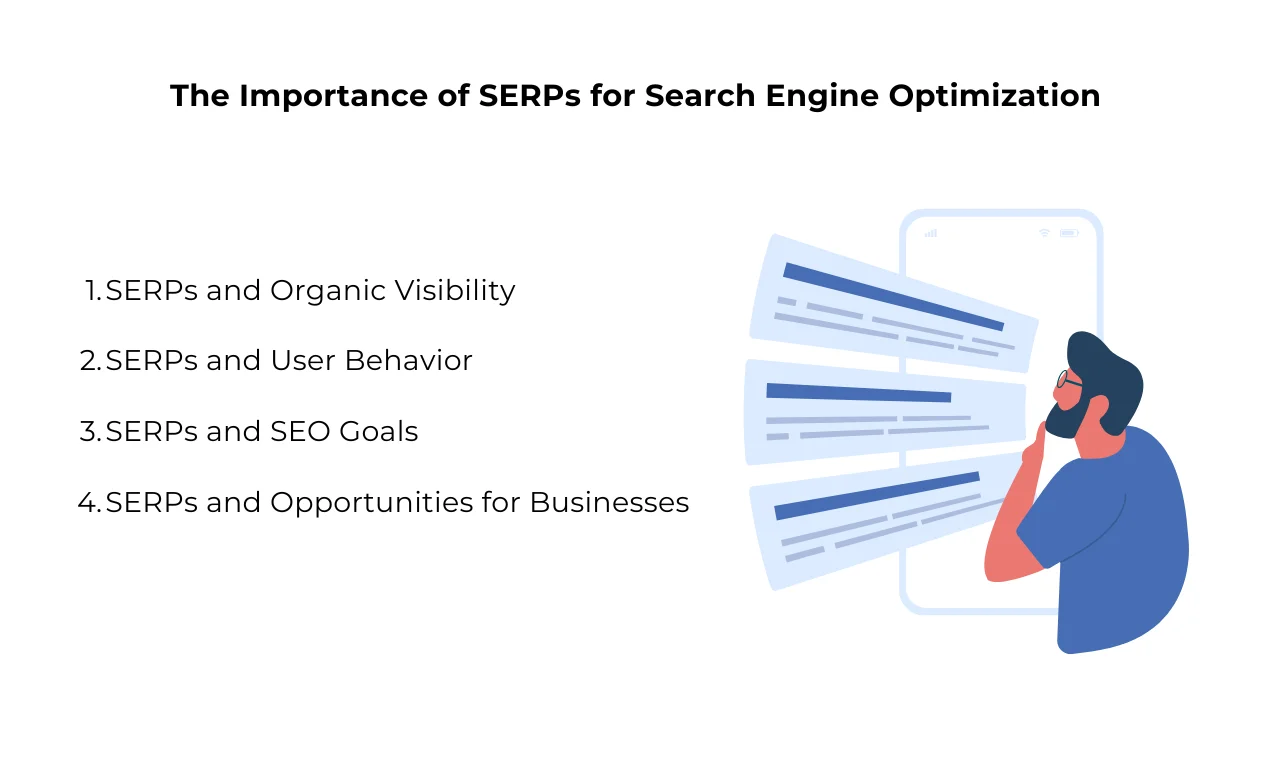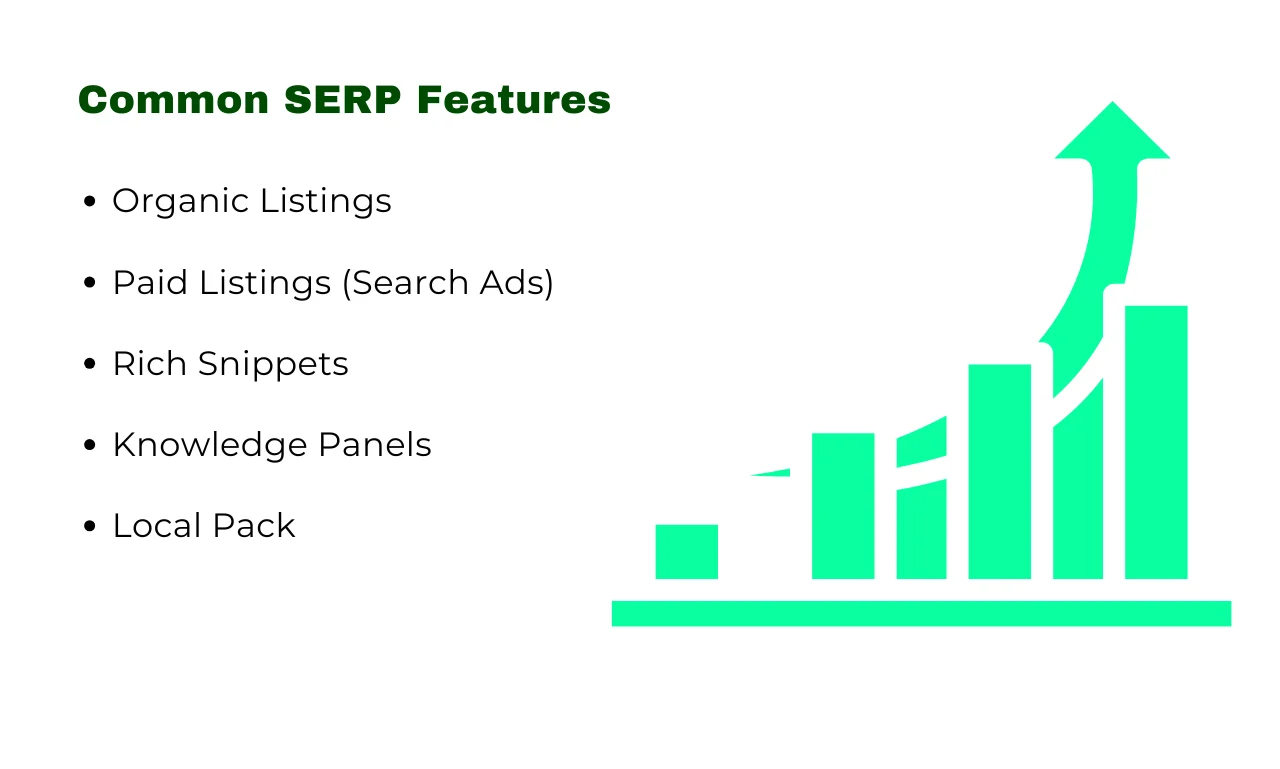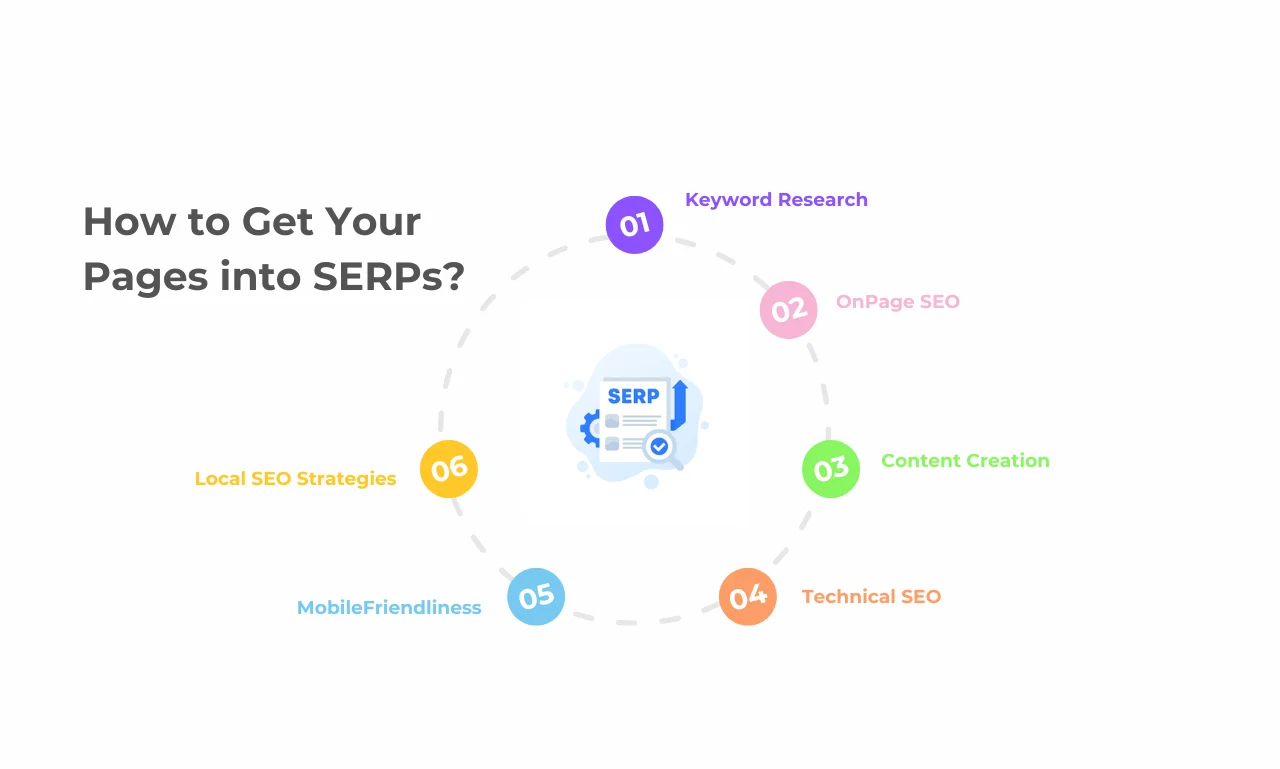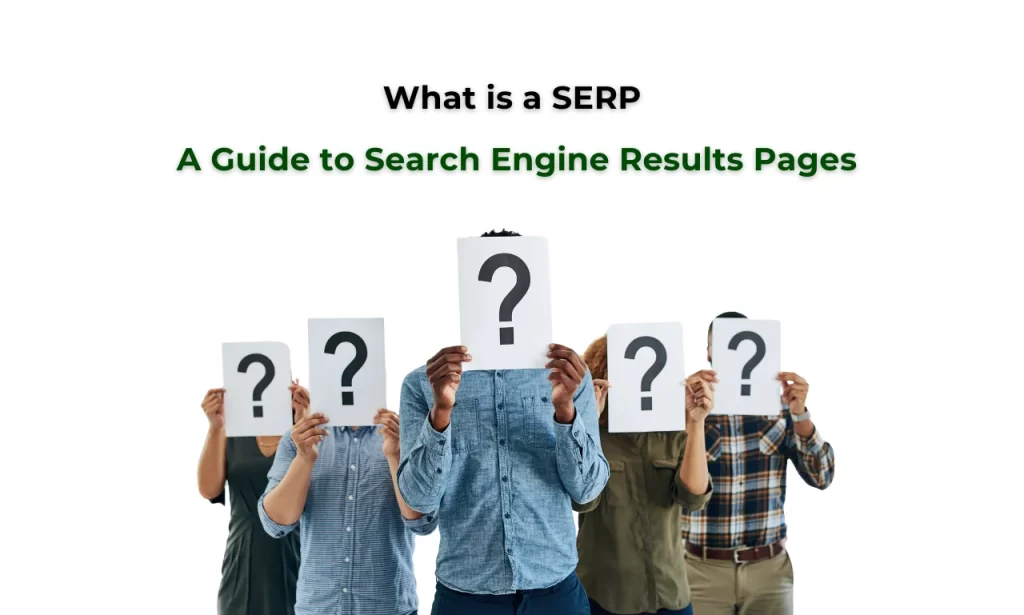On the Internet whether your content is indexed or not is primarily determined by Search Engine Results Pages or SERP. If you understand the whole working process, then it is essential to know what SERPs mean, what they stand for, and how only a few particular sites appear on the first page of the search results when the users insert the initial word/phrases in the search bar and push enter. In this guide, we will explain SERPs in relation to their relevance for SEO, as well as how they can be utilized to the benefit of a business. So, let’s dive in!
I. Introduction to SERPs
What Is a SERP?
Now suppose you are searching for something. You turn on your computer, go to the Web, and begin to type on the search bar of your preferred search engine. That is the SERP that comes up on a Search Engine Results Page. This page consists of related links and brief details as per your searched term.
Indeed, a SERP is much more than just a list of websites as we can see in this example.
It is an innovative platform that offers a quick and easy way of getting an individual to relevant content. The goal? To provide the most appropriate results for your searches.
Why SERPs Matter in Digital Marketing?
SERPs literally determine the first impression of a brand for a typical internet user in the course of his or her browsing activity for a specific search term of interest. SERPs decide whether the target consumers will be able to locate your website. So, it is crucial to comprehend SERPs for any business or marketer for their use and their significance in ranking the website.
Why? This is because the position of a website on SERP is important since it determines the number of clicks from potential customers. If you do not have good mastery of SERPs it will be so hard for your online marketing strategies to succeed.
II. The Importance of SERPs for Search Engine Optimization (SEO)
An insight into SERPs is a good way of mastering the essence of SEO. The goal of SEO techniques is to possibly enhance the site placement within the SERPs. Let’s break this down further.
A. SERPs and Organic Visibility:
A SERP performs two main things, the first of which is presenting the results of search queries in ranking and second determining organic visibility. It is critical that your website is located on this page as this determines its placement on the page. This makes users visit your site more frequently and rate it more often especially when it ranks at the top of the list.
But why does ranking matter? A website ranking has been found to be directly proportional to the flow of traffic on a particular website or webpage. It is a straightforward link between you and the potential clients who visit your site and check out your content.
B. SERPs and User Behavior:
User behavior explains why people interact with SERPs in certain manners, as a result of the impressions that they receive. There is a significant impact from the layout, the features, and the types of results to the amount of clicking responses that are given. For example, if there is a featured snippet that answers most user’s inquiries at the top of the SERP, then the user may not have to click farther down the SERP.
It is important for you to have a clue of what users do on SERP when they insert a particular keyword or phrase. It assists you in aligning your SEO approaches with user expectations, search goals, and objectives.
C. SERPs and SEO Goals:
SERPs precisely indicate the success you have achieved with your SEO endeavor. Every time your SEO campaigns coincide with search engine algorithms, there will be an improvement in your website’s position. This is an indication that all the efforts put into SEO are realized.
SERPs alone are used to measure success in terms of ranking position, click-through rate, and such other features as featured snippets and knowledge panels. All of these can be used to gain an understanding of how the current SEO strategy is working.
D. SERPs and Opportunities for Businesses:
To businesses, specific entry SERPs constitute one of the most fascinating environments. It provides a venue through which you can reach out to your intended audience through indexing your web content. But it may appear on a great number of SERP, which is not only important for itself. More precisely, it is about using some of the options provided by it.
Consider elements such as local packs, image packs or the ‘People also ask’ section. These are the possibilities to advertise your business outside of link-based results. By taking into consideration some of these features and redesigning some to fit your SEO approach, you can put your business in a position to improve its online market potential.
III. How to Leverage SERPs for Business Success?
Now that you have understood the basics of SERPs let us proceed to explain how it can be beneficial to your business ventures.
1. Optimize for Featured Snippets:
It is usually a brief text element located on SERP entirely at the top to directly respond to the search queries.
If you are able to answer them faithfully in a question-and-answer format, you will have a good chance of landing this highly desirable spot. That is why Featured Snippets are the best way to get attention and attract traffic towards the link.
2. Focus on Local SEO:
Local SEO is mandatory in case your company has a physical store. It’s a location-based search, where the result displayed consists of the closest businesses to the user. Local SEO entails claiming your GMB listing, acquiring local backlinks, and having the same NAP currently, Name, Address, and Phone number information on the website.
3. Create Engaging Content
Content is king, however, if you are invisible, nobody wants to see even the king. The content you come up with should meet the expectations of the users looking for your content. To that effect, you should conduct proper keyword research so that you realize what your audience would like to read and write. Well-written content with catchy titles, subheadings, and material always draws the interest of the readers
4. Utilize Multimedia
Quality and relevant images, videos, and infographics are essential criteria for increasing the visibility of a URL on SERP. Such sections can be added to image or video galleries and will make your site more engaging. By utilizing different content types, you can attract more traffic to your blog.
5. Monitor and Adapt
Over the past few years, the nature of SERPs has been dynamic with the searchers demanding new features and the search engines delivering it for them. As search engines are dynamic; they change the type of results displayed from time to time. This is the reason why you should take your time often to check your Specific Event Requested Page performance. Take advantage of other tools such as Google Search Console to monitor your site’s status and discover room for further optimization. It is significant to remain notified about algorithm updates and changes should be made according to the update.
IV. Common SERP Features
Organic Listings:
Organic results are by far the most crucial components of SERP features as they provide the most value to the users. They come up naturally depending on the relation of the page to the entered search results. If you want to get better results then you have to put special focus on different kinds of factors such as:
- Keyword Volume
- Keyword Difficulty
- Long tail Keywords vs Short tail Keywords
- Local Keywords vs Global Keywords
While paid advertisements are placed to appear in the search results, the organic results are organically employed based on SEO efforts.
The major components of any given organic listing are three, which are as follows:
- It is the blue text or a short line at the top of any given result that is clickable. It has to be understandable and informativeness should be high.
- A summary of the page content. It should encourage a clickthrough.
- It was ascertained that a clear and descriptive URL had the potential to enhance the clickthrough rates.
Paid Listings (Search Ads)
Paid search results or AdWords are displayed on the top or bottom of SERP. It is a paid advertisement that businesses get to post on the website. Google Ads is the widely used platform to put into practice most forms of commercials.
In terms of appearance, paid results are quite different from organic results:
- Prominence: Paid ads are always placed at the top of the search engine results and this makes them prominent.
- Cost: Paid ads differ from organic results as the former always comes attached with a specific fee.
- Performance Measurement: It enables the advertisers to monitor the overall performance and even set the bid in real-time.
Rich Snippets:
Inorganic listings are a presence on web pages that don’t offer any enhanced business listing with more related information called rich snippets. They employ account information to present such specifics as ratings, reviews, and prices. Such values are recipe and ingredient, date, and price of the product.
Data that is properly organized and preferably in JSON-LD format is advantageous to search engines in terms of comprehension. This leads to the postings of more detailed and eye-catching ads.
Knowledge Panels:
These are panels in the search results that provide the user with quick responses to ask questions relating to a certain search value. They are a vertical block on the right of the SERP containing brief information on an entity, whether an individual, company or geographical location.
It is advised that data from these panels is obtained from sources such as Wikipedia, Google + and other news. You can even get snapshots of what you require without the need to visit a website.
Local Pack:
The local pack refers to a set of three local listings that are usually stipulated at the pinnacle of any SERP. This is evident when users are in search of services from a particular location or any type of business. The pack includes:
- Business Name: The name of the business.
- Rating: The average star rating from reviews.
- Proximity: The degree of distance that the business is located away from the user.
- Communication with the company: Phone and the physical address of the company.
Local SEO is necessary if you want to achieve high positioning in the local pack. It is the process of managing your website to rank higher in a specific geographical location.
V. How to Get Your Pages into SERPs?

Keyword Research:
Keyword research is perhaps the most important and crucial factor that contributes to the SEO process. That is why it is critical to find the right keywords and search queries that you will use in your content.
To find such keywords, you can use Google Keyword Planner or tools like SEMrush or Ahrefs. Considering the three factors such as the number of searches, competition, and user intentions, it is easy to choose the ideal keywords for the strategy.
OnPage SEO:
On-page SEO is the optimization of single pages of a website. Focus on elements like:
- Title Tags: Place your main keywords at least in the title tags and make them appealing.
- Meta Tags: Write an outline of the content briefly in a sense that would compel users to click.
- Headings: This element is to be placed between H1 and H3 and should contain keywords.
For the URL to be clean and easy to remember, avoid complex URL constructors that include parameters with multiple variables and values. The internal linking assists the search engine in its crawling of the site because it makes it easy for Google crawlers to scan your website.
Content Creation:
To position your website high in SERPs it is inevitable to produce high-quality content. Focus on:
- Relevance: Align content with user intent and search queries.
- Engagement: Must grab people’s attention by incorporating meaningful stories and pictures.
- Value: Deliver information that meets the user information needs.
Always refresh your content so that it does not look similar to another in order to meet the needs of the clients.
Technical SEO:
Technical SEO refers to ensuring your website is optimized for the use of the search engine and its users. Key aspects that you can consider in this regard include:
- Website speed: Reduce the size of the image file if possible and use the caching technique.
- Mobile Chums: This feature entails that your site should be optimally viewable on all the various gadgets that users may use to access it.
- Accessibility: Implement the accessibility standards for designing a site that will be accessible to all users.
This feature aims to help the crawler understand the overall structure of your site and enable suggested improvements to make the structure work effectively. Sitemaps and robots.txt files should be used for directing the search engine bots.
Mobile Friendliness:
As people tend to spend more time on their mobile devices browsing websites it has become important to design with a mobile-first approach. It is equally important that you check whether your site is optimized for mobile devices and the speed at which it loads on a mobile device.
Additionally, the SERP ranking can be greatly improved when there is a proper mobile experience on your site.
Local SEO Strategies:
Local SEO is enormously important in the markets that operate businesses and target their local customers. The first step is to make the creation of a Google My Business account. This improves your chances of ranking high in the local search engine listing.
Create citations by submitting business listings to directories. Learn in this article how to deal with the management of online reputation in an attempt to increase the number of customer acquisitions.
VI. How Do Google SERPs Work?
To get the complete picture of SERPs, you have to know how Google or any other search engine understands the query and ranks the results. Here, the factors are explained, including the elements of the ranking system, the intent of the users, and the dynamics of SERP, as well as the progression of ML & AI in shaping what we find on our screens.
How Google Interprets Search Queries?
Understanding Query Intent and Context:
With every query that a user enters in Google, the search engine engages in natural language processing to understand the user’s purpose. Based on the type of website, its visitors’ intent can be either informative, navigational, or transactional. For instance, ‘How to bake a cake’ is informational, ‘Facebook login’ is navigational, and ‘Buy iPhone’ is a commercial. Google applies this intent to provide the most suitable information.
How Google Matches Content to User Needs?
The process of selecting suitable content that meets the needs of the user arises from the evaluation of the relevance and quality of the web pages. Google takes into consideration several hundreds of factors to identify which web pages can meet the user’s needs to the maximum. This is why good content can rise to the positions.
The Ranking Process:
Google’s algorithm is a set of conduits that are used to define the order of the page in accordance with certain factors. These are relevance, authority, user experience, and so forth. Although the specifics of its algorithms cannot be disclosed, we are aware of the roles that feature such as keyword intensity, backlinks, or mobile-friendliness among others.
Role of Relevance, Authority, and User Experience:
Relevance relates to the extent to which a given page is related to the search term input by the user, Authority referred to as the popularity of a site, relates to the trust customers put in a certain site, carved by usual links from other prominent sites. User experience encompasses factors like page speed, mobile responsiveness, and ease of navigation.
The Role of User Intent:
The user intent plays its role not only in ranking but in SERP layout as well. For example, information search queries may reveal the featured snippets or knowledge panel while there were commercial search queries might reveal the shopping ads and price comparison tools.
Examples of Informational, Navigational, and Transactional Queries:
User intent that is reflected in Informational queries is as follows: It targets these queries, for example, “What is SEO?”. A navigational query is to locate a specific site, for instance, a YouTube home page. Transactional Queries are used in a search to make a transaction or a subscription, for instance, “buy running shoes.”
SERP Diversification:
The goal of its search engine is to deliver several service responses to almost all the questions submitted by users. This consists of organic results, advertisements, featured snippets, local search packs, and many others. Diversification enables users to access desired items conveniently and within the shortest time possible.
How does Diversification Improve the Experience of the User?
Google provides users with a diversified content type to meet their needs and pursue interests. It not only enhances the satisfaction of the users but also provides opportunities for the targeted advertisement of the products and services on different platforms.
The Impact of Machine Learning and AI:
Based on the behavior of the users, machine learning and AI enable Google to further develop its algorithms. This helps in making sure SERPs are still valid and valuable, regardless of new tendencies observed.
The Role of RankBrain and Other Machine Learning Models:
RankBrain is part of Google’s algorithms, allowing the search engine to use AI for the analysis of detailed questions and provide more meaningful and accurate results. Other Machine Learning helps to understand context, synonyms and user intent much better than the previous models of Google.
VII. How to Appear in SERPs?
Ranking in SERPs also involves formatting, using SEO, PPC, performance, snipped, and local SEO strategies. To add to this, below are ways through which you can increase exposure;
Search Engine Optimization (SEO):
SEO is a marketing strategy that focuses on enhancing the website’s visibility on the Search Engines Result Pages. Some of the proper guidelines involve keyword optimization, content creation, focus on the speed of the site and mobile-friendliness.
The Importance of Consistency and Long-term Effort:
Search engine optimization is a long-term process that a website owner has to go through time and again. There is a need to make a constant effort at regular intervals to ensure that you are constantly on the right top rank. It is a long-term commitment to update the content frequently and actively work on building backlinks besides monitoring the search algorithms.
Search Ads (PPC):
Paid searching also known as Pay-Per-Click (PPC) enables you to be featured on SERPs through paid result lists. Google Ads, which provides ads placed according to the keyword usage or unavailable search results.
Strategies for Creating Effective PPC Campaigns:
Managing PPC can be effective, but there is a need to plan in a proper manner to ensure everything is well-optimized. Key steps, which must be taken include defining objectives, selecting keywords, writing effective headings and ad text, as well as considering the means of checking account performance.
Track Your Performance in SERPs:
To monitor your improvements, use elements like Google Search Console as well as Analytics. These tools give an indication of your company’s search website traffic, rankings for keywords, and the overall behavior of the users.
Monitor Keyword Rankings and Click-Through-Rates:
Closely track keywords and CTR as these will inform the degree of success of your SEO and PPC strategies. Make changes periodically depending on performances in keywords for better efficiency.
Optimize for Featured Snippets:
Highlighted snippets or position zero, is one of the most attractive positions in the SERPs. To optimize how you appear in search results, it is very important to make your content as friendly to search engines as possible.
Structure Content to Answer User Questions:
It is useful to separate the content into headings, points, and tables so that Google can easily pull out all the snippet portions of content. It also advised that answering questions directly and concisely can also help in increasing your chances.
Leverage Local SEO:
Local SEO is critical for the enhanced ranking of an organization targeting local customers. Create the profile on Google, briefly optimize the listing, and then remind customers to leave a review while making sure that NAP information is the same across various sources.
Importance of Local Citations and Reviews:
The Local citations and reviews are justifications for why local SEO matters in the current marketing strategy. They contribute to the creation of business credibility and appearance to regional search engines, so people visit again and again to your site.
VII. Conclusion
SERPs are simply not limited to a list of links that appear on the screen after a search. They developed an intricate relationship between the user and the results intended to be provided to him or her. It would also be important for businesses and markets to gain a deeper understanding and appreciation of SERPs to attain online prominence.
To gain more information about SERPs, you can contact Three Angle Marketing experts any time you like. Our experts are 24/7 ready to help you streamline your SERP results.


